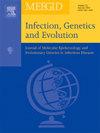Endemic transmission of a Mycobacterium tuberculosis L2.2.M3 sublineage of the L2 lineage within Colon, Panama: A prospective study
IF 2.6
4区 医学
Q3 INFECTIOUS DISEASES
引用次数: 0
Abstract
Mycobacterium tuberculosis lineage 2 (L2) remains a globally significant lineage associated with increased drug resistance and rapid transmission. The L2 lineage exhibits a hotspot for genetic diversity and evolution in Panama, requiring an in-depth analysis. We conducted a prospective analysis of 274 Mycobacterium tuberculosis L2 isolates from Colon City between January 2021 and October 2023. Drug resistance was determined using GeneXpert and MTBDRplus-Genotype assays, strain lineage was determined by strain-specific PCR (ASO-PCR), and whole-genome sequencing was conducted for phylogenetic analysis. Sequencing data were analyzed using the mtb-call2 pipeline and TB-gen tools to predict drug resistance and sublineage, respectively. Genome-wide single-nucleotide polymorphisms (SNPs) were used for phylogenetic and evolutionary analyses. ASO-PCR results identified all 31.7 % (86/271) isolates as Modern L2.2. WGS analysis of 66 strains confirmed all isolates belonged to the L2.2.1 sublineage. Sixty-four strains were analyzed in depth, with 96.9 % (62/64) classified as pan-susceptible and 3.1 % (2/64) as rifampicin/pyrazinamide-resistant. The sublineage analysis based on SNPs using the TB-gen tool identified a SNP at position 1219683G > A, which genotyped all 64 strains as L2.2.M3 sublineage. Phylogenetic analysis revealed a correlation with geographical distribution compared to other Latin American L2 isolates. Transmission clusters (≤12 SNPs) were identified and used to determine recent transmission events or TB transmission clusters. These analyses also confirmed a relatively low evolutionary rate within Panama L2 isolates and a highly conserved common ancestor shared with L2 isolates from Peru, Colombia, and Guatemala. These findings suggest endemic transmission of the Mycobacterium tuberculosis L2.2.M3 sublineage in Colon, Panama. We recommend combining genomic information with epidemiological data to accurately track and identify the source hotspot for the L2.2.M3 sublineage and focus control measures.
结核分枝杆菌L2.2的地方性传播。巴拿马科隆L2谱系的M3亚谱系:一项前瞻性研究
结核分枝杆菌谱系2 (L2)仍然是与耐药性增加和快速传播相关的全球重要谱系。L2谱系是巴拿马遗传多样性和进化的热点,需要深入分析。我们对2021年1月至2023年10月期间从科隆市分离的274株结核分枝杆菌L2株进行了前瞻性分析。采用GeneXpert和mtbdrplus基因型检测方法检测耐药性,采用菌株特异性PCR (ASO-PCR)检测菌株谱系,并进行全基因组测序进行系统发育分析。测序数据分别使用mtb-call2管道和TB-gen工具预测耐药和亚谱系。全基因组单核苷酸多态性(snp)用于系统发育和进化分析。ASO-PCR结果显示,31.7%(86/271)分离株均为现代L2.2。66株菌株经WGS分析均属L2.2.1亚系。对64株病原菌进行深入分析,96.9%(62/64)为泛敏感菌,3.1%(2/64)为耐药菌。使用TB-gen工具进行基于SNP的亚谱系分析,鉴定出1219683G >位置的SNP;结果表明,64株菌株的基因型均为L2.2。M3 sublineage。系统发育分析显示与其他拉丁美洲L2分离株的地理分布相关。发现传播集群(≤12个snp)并用于确定最近的传播事件或结核传播集群。这些分析还证实了巴拿马L2分离株的进化率相对较低,并且与秘鲁、哥伦比亚和危地马拉的L2分离株具有高度保守的共同祖先。这些发现提示结核分枝杆菌L2.2的地方性传播。巴拿马科隆的M3支线。我们建议将基因组信息与流行病学数据相结合,准确跟踪和识别L2.2的源热点。M3次渗透及焦点控制措施。
本文章由计算机程序翻译,如有差异,请以英文原文为准。
求助全文
约1分钟内获得全文
求助全文
来源期刊

Infection Genetics and Evolution
医学-传染病学
CiteScore
8.40
自引率
0.00%
发文量
215
审稿时长
82 days
期刊介绍:
(aka Journal of Molecular Epidemiology and Evolutionary Genetics of Infectious Diseases -- MEEGID)
Infectious diseases constitute one of the main challenges to medical science in the coming century. The impressive development of molecular megatechnologies and of bioinformatics have greatly increased our knowledge of the evolution, transmission and pathogenicity of infectious diseases. Research has shown that host susceptibility to many infectious diseases has a genetic basis. Furthermore, much is now known on the molecular epidemiology, evolution and virulence of pathogenic agents, as well as their resistance to drugs, vaccines, and antibiotics. Equally, research on the genetics of disease vectors has greatly improved our understanding of their systematics, has increased our capacity to identify target populations for control or intervention, and has provided detailed information on the mechanisms of insecticide resistance.
However, the genetics and evolutionary biology of hosts, pathogens and vectors have tended to develop as three separate fields of research. This artificial compartmentalisation is of concern due to our growing appreciation of the strong co-evolutionary interactions among hosts, pathogens and vectors.
Infection, Genetics and Evolution and its companion congress [MEEGID](http://www.meegidconference.com/) (for Molecular Epidemiology and Evolutionary Genetics of Infectious Diseases) are the main forum acting for the cross-fertilization between evolutionary science and biomedical research on infectious diseases.
Infection, Genetics and Evolution is the only journal that welcomes articles dealing with the genetics and evolutionary biology of hosts, pathogens and vectors, and coevolution processes among them in relation to infection and disease manifestation. All infectious models enter the scope of the journal, including pathogens of humans, animals and plants, either parasites, fungi, bacteria, viruses or prions. The journal welcomes articles dealing with genetics, population genetics, genomics, postgenomics, gene expression, evolutionary biology, population dynamics, mathematical modeling and bioinformatics. We also provide many author benefits, such as free PDFs, a liberal copyright policy, special discounts on Elsevier publications and much more. Please click here for more information on our author services .
 求助内容:
求助内容: 应助结果提醒方式:
应助结果提醒方式:


